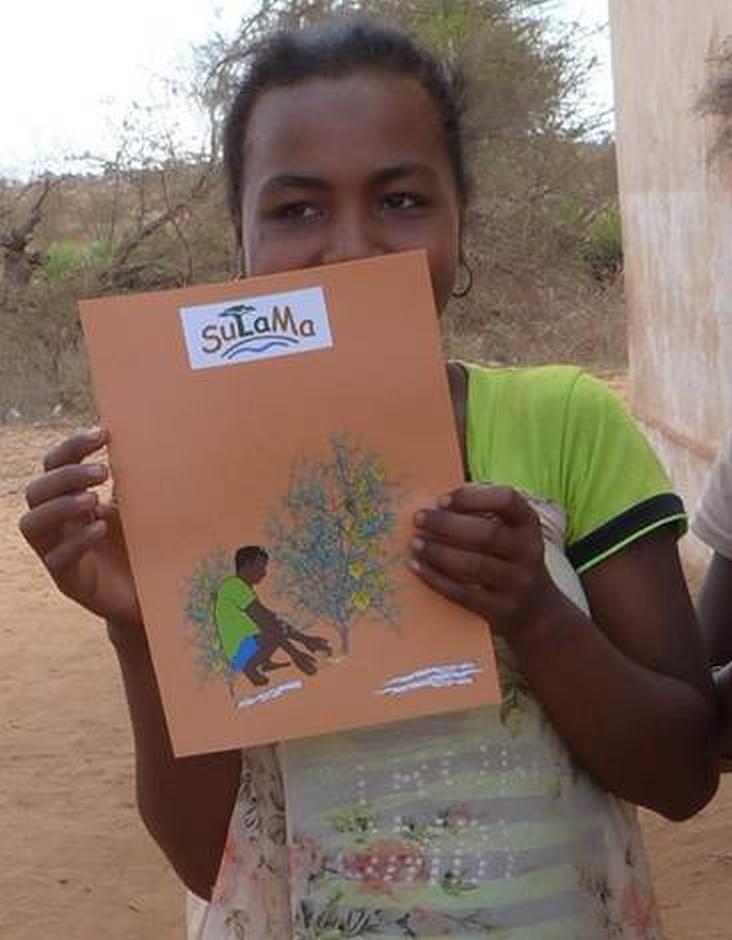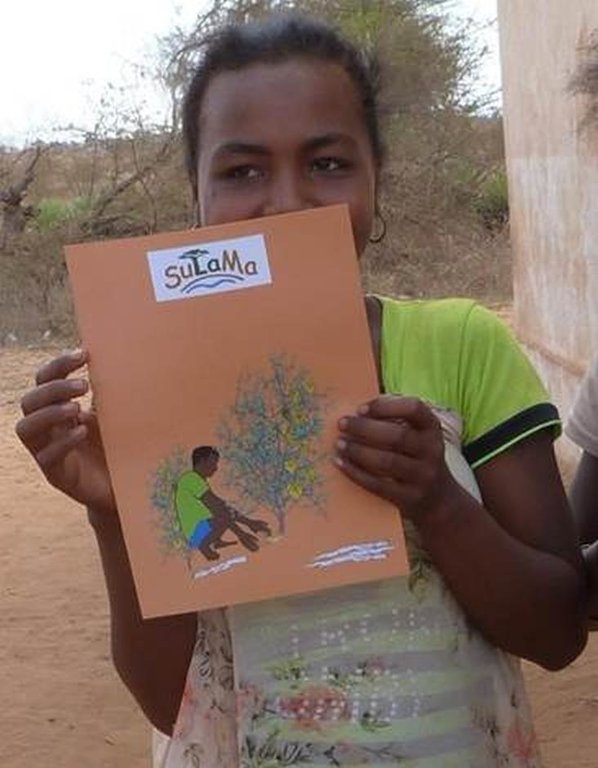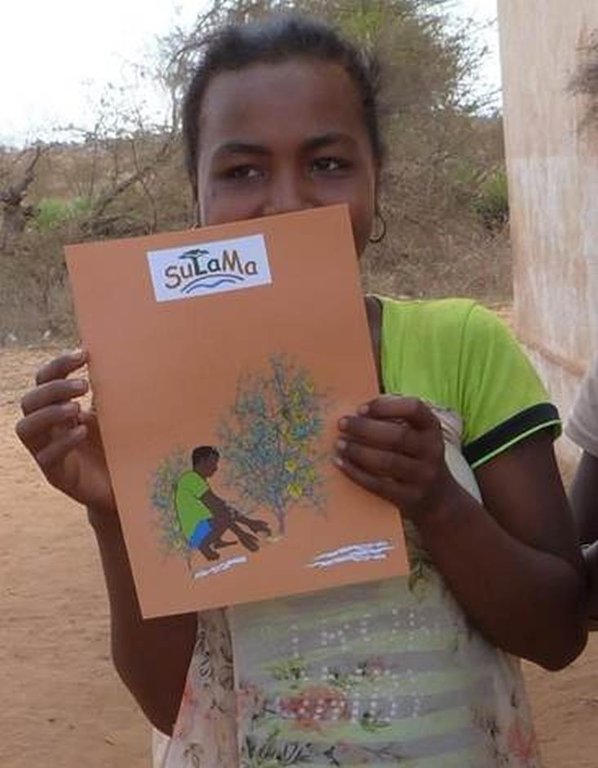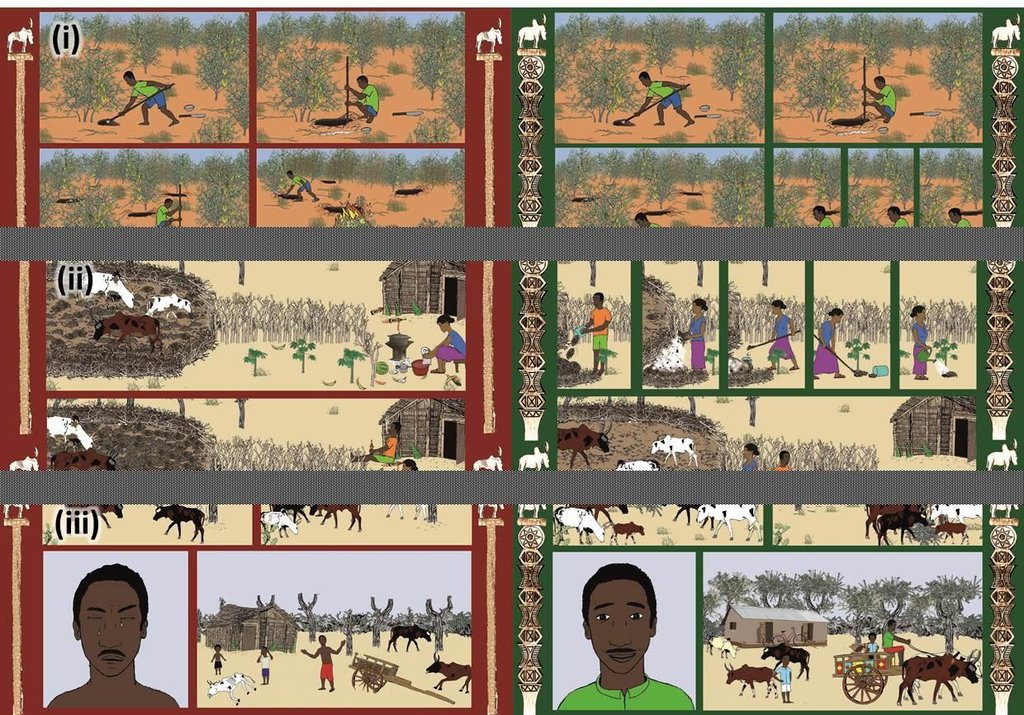Increasing environmental awareness using comic-style illustrations as a visual communication tool [Мадагаскар]
- Создание:
- Обновить:
- Составитель: Tobias Feldt
- Редактор: –
- Рецензент: Fabian Ottiger
approaches_2545 - Мадагаскар
Просмотреть разделы
Развернуть все Свернуть все1. Общая информация
1.2 Контактные данные специалистов и организаций, участвующих в описании и оценке Подхода
Специалист по УЗП:
Weiss David
mail@david-weiss.com
David Weiss Agrarcomics
Kirchstraße 18, D-37214 Witzenhausen http://david-weiss.com
Германия
Название проекта, содействовавшего документированию/оценке Подхода (если применимо)
Sustainable Landmanagement in south-western Madagascar (SuLaMa / GLUES)Название организации (-ий), содействовавших документированию/оценке Подхода (если применимо)
Universität Kassel - Германия1.3 Условия, регламентирующие использование собранных ВОКАТ данных
Когда были собраны данные (на местах)?
01/10/2015
Составитель и ответственный/-ые специалист(-ы) согласны с условиями, регламентирующими использование собранных ВОКАТ данных:
Да
1.4 Ссылка (-и) на Анкету (-ы) по Технологиям УЗП
2. Описание Подхода УЗП
2.1 Краткое описание Подхода
Communicating and transferring scientific results and recommendations about sustainable land management to local people
2.2 Подробное описание Подхода
Подробное описание Подхода:
Aims / objectives: The central aim of this approach was to increase environmental awareness in the Mahafaly region of southwestern Madagascar using visual communications tools. Comic-style illustrations were originally designed to communicate scientific recommendations on sustainable land management (SLM) and to ensure knowledge transfer from scientists to local people.
Methods: Visual communication, based on pictures, drawings, movies, sequential images and posters plays a vital role in countries where many people are illiterate. Another advantage is its easy reproduction in comparison to oral communication. It may also transfer knowledge where oral communication fails because of linguistic barriers or simply because complex narratives and messages are easier to explain visually than orally. In the context of a participatory research project to support SLM on the Mahafaly Plateau in southwestern Madagascar, comic-style illustrations of visual narratives were used to focus on environmental problems and SLM strategies. Since cross-cultural differences arise in “visual languages” globally, the visualization style needs to be carefully selected. Furthermore, misunderstanding of visual narratives may occur when objects are drawn not realistically enough, or if the statement is abstract or only presented from a scientific The central aim point of view. To avoid misinterpretation and increase readability and local acceptance, the style of comics was specifically designed for the conditions in rural Madagascar using a traditional Malagasy art style (sepulchre art in the form of “Aloalo” tomb sculptures). Comic illustrations were prepared to show the impact of different land use practices on the environment and local livelihoods using two contrasting stories/scenarios. The “red story” depicts a worst case scenario of unsustainable practices that are often applied by local inhabitants and the “green story” shows an example of a best case scenario based on an alternative, sustainable land management option recommended by scientific experts. To keep the stories simple and understandable, there was a focus on scientific key messages which can be easily transformed into visual narratives - and technical details were left aside.
Stages of implementation: The six year (2011-2016) transdisciplinary research consortium of Malagasy and German universities was initiated in the Mahafaly region of southwestern Madagascar in order to support sustainable land management (SuLaMa = Sustainable Land Management in southwestern Madagascar). Based on scientific research regarding the diversity and local use of forest resources and SLM practices in animal and crop husbandry, key messages and recommendations, which were easy to implement, were formulated by the scientific experts. Two examples of overused natural resources and one example of a neglected soil improvement practice were chosen for comic-style illustrations and transformed to visual narratives. These are (i) sustainable harvesting practice of wild yams (Dioscorea bemandry); (ii) composting of manure and its application to improve soil fertility and yields in home gardens; and (iii) sustainable utilization of the succulent tree Euphorbia stenoclada (called 'samata' in the local dialect) as supplementary forage for livestock. During an inception phase for the implementation of visual narratives in the study region, different drawing styles were tested and assessed to gather information on the local perception of art. Drawing styles showing the highest acceptance rate and readability were subsequently used to prepare the comics. The comics were printed on robust clay coated paper and handed out to local inhabitants during larger village workshops, where the different stories were presented and discussed.
2.3 Фотографии, иллюстрирующие Подход
2.5 Страна/ регион/ место, где применялся Подход
Страна:
Мадагаскар
Административная единица (Район/Область):
Atsimo-Andrefana (South-West Madagascar)
Более точная привязка места:
Toliara II
2.6 Даты начала и окончания реализации Подхода
Год начала реализации:
2015
Год окончания (Если Подход больше не применяется):
2016
2.7 Тип Подхода
- в рамках проекта/ программы
2.8 Каковы цели/ задачи Подхода
The Approach focused mainly on SLM with other activities (sustainable land use, livestock husbandry, crop production, yams)
Comic-style illustrations were designed for environmental education purposes to communicate scientific results and recommendations on sustainable land management and ensure knowledge transfer from scientific experts to local people. It is the general aim of the approach to raise awareness for sustainable land use and environmental protection and therefore to improve both people's livelihoods and the efficiency in the use of natural resources.
The SLM Approach addressed the following problems: The approach area is characterized by low agricultural production, a lack of technical knowledge, low education level and conflicts over resource use.
2.9 Условия содействующие применению Технологии/ Технологий в рамках Подхода или затрудняющие его
Социальные/ культурные/ религиозные нормы и ценности
- затрудняют
People in the project area have a cultural reservation towards the utilization of animal dung, thus renouncing one of the fundamental principles for soil amelioration. At the same time, the declination of handling the animals' feces and therefore hardly ever cleaning their night enclosures strogly increases the risk of epizootic diseases and parasite infections.
Treatment through the SLM Approach: The comic drawings attempt to demonstrate how simple measures may have a sustainable impact in improving people’s livelihoods in many ways. They will at best be food-for-thought to reconsider culture-based practices that are not good SLM practice.
Нормативно-правовая база (землевладение, права на земле- и водопользование)
- затрудняют
With regard to the sustainable utilization of fodder trees, land ownership conflicts may arise as most of these trees around settlements stand on private ground – but without clear demarcation.
Treatment through the SLM Approach: Where currently there only exist single cactus plants or other hardly recognisable natural markings between plots, clear boundary lines between those plots could be illustrated as a good alternative in the respective comic.
The existing land ownership, land use rights / water rights hindered a little the approach implementation Some contents presented in the comic drawings, such as on the sustainable utilization of fodder trees, can conflict with land ownerships as most of these trees around settlements stand on private ground. Boundary lines between these plots, often only consisting of single cactus plants or other natural markings, may not be recognizable for outsiders but have to be included into the comics to avoid missunderstandings.
Объем работ, доступность рабочей силы
- затрудняют
Local people often do not see a direct benefit from higher workload e.g. by a more careful harvesting of forest products, the cleaning of livestock enclosures, or the utilization of manure for soil amelioration.
Treatment through the SLM Approach: The approach aims to show plainly the positive and sustainable impact of the alternative practices and the effect on people’s livelihoods.
другие
- затрудняют
The concept of some natural resources being finite is not very widespread among the local population.
Treatment through the SLM Approach: The approach may help local people to become more aware of this problem and to induce the
establishment of more sustainable land use practices.
3. Участие и распределение ролей заинтересованных сторон
3.1 Заинтересованные стороны, участвующие в реализации Подхода и их роли
- местные землепользователи/ местные сообщества
Crop and livestock farmers
Livestock related topics were addressed to male farmers as they are mainly involved in livestock husbandry.
- общественные организации
- местные власти
municipality, village
- государственные власти (отвечающие за планирование или принятие решений)
- международные организации
3.2 Участие местных землепользователей/ местных сообществ на разных стадиях реализации Подхода
| Участие местных землепользователей/ местных сообществ | Перечислите участников и опишите их вовлеченность | |
|---|---|---|
| инициирование/ мотивация | нет | |
| планирование | интерактивное | data surveys, questionnaires, group discussions |
| выполнение | внешняя поддержка | village workshops to present the comics and to explain the storylines. |
| мониторинг/ оценка | интерактивное | stepwise evaluation and improvement of comic understanding and acceptance by land users and the community |
| Research | пассивное |
3.3 Схема реализации (если имеется)
Описание:
Extracts of three storylines on (i) yams harvesting, (ii) manure composting and (iii) the utilization of ‘samata’ (Euphorbia stenoclada)
Автор:
D. Weiss
3.4 Принятие решений по выбору Технологии/ Технологий УЗП
Укажите, кто принимал решение по выбору применяемой Технологии/ Технологий:
- преимущественно специалисты по УЗП после консультаций с землепользователями
Поясните:
During the six-year term of the original project, researchers gained a deep inside into the daily routine and workflow of the local population. The technology approach was therefore based on this knowledge and aimed at some of the major problems identified.
Decisions on the method of implementing the SLM Technology were made by mainly by SLM specialists with consultation of land users
4. Техническая поддержка, повышение компетенций и управление знаниями
4.1 Повышение компетенций/ обучение
Проводилось ли обучение землепользователей/ других заинтересованных лиц?
Да
Укажите, кто проходил обучение:
- землепользователи
- местный персонал/консультанты
Тип обучения:
- опытные участки
- общие собрания
4.2 Консультационные услуги
Есть ли у землепользователей возможность получать консультации?
Да
4.3 Институциональная (организационная) поддержка
В ходе реализации Подхода были ли организованы новые институциональные структуры или поддержаны уже существующие?
- да, умеренно
Укажите уровень, на котором структуры были укреплены или вновь созданы:
- местные
Укажите тип поддержки:
- финансовая
- повышение компетенций/ обучение
- оборудование
Подробнее:
Local schools can be equipped with material and practical training courses can be developed with the collaboration of teachers, village chiefs and elders.
4.4 Мониторинг и оценка
Являются ли мониторинг и оценка частью Подхода?
Да
Комментарии:
technical aspects were regular monitored by project staff through observations; indicators: Data on land use practices were collected.
technical aspects were regular monitored by project staff through measurements; indicators: Data on human well-being and social conventions (customs, traditions, rituals) were collected.
socio-cultural aspects were regular monitored by project staff, land users through observations; indicators: Comics were distributed to land users and discussed with representatives of 15 villages.
no. of land users involved aspects were ad hoc monitored by None through observations
Evaluation aspects were ad hoc monitored by project staff through observations; indicators: evaluation of understanding and acceptance of comics
There were several changes in the Approach as a result of monitoring and evaluation: The understanding of the comics, their acceptance and the possible implementation of the land use approaches still have to be investigated during a follow-up evaluation process. There were few changes in the technologies. This still needs to be investigated during the evaluation process.
There were few changes in the Technology as a result of monitoring and evaluation: This still needs to be investigated during the evaluation process.
4.5 Научные исследования
Были ли научные исследования частью Подхода?
Да
Укажите темы исследований:
- социология
- экономика / маркетинг
- экология
- технология
Напишите подробнее и назовите тех, кто выполнял исследования:
Research was carried out on-farm
5. Финансирование и внешняя материальная поддержка
5.1 Годовой бюджет мероприятий по УЗП в рамках Подхода
Если точный годовой бюжет неизвестен, укажите примерный диапазон затрат:
- 2000-10000
Комментарий (например, основные источники финансирования/ ключевые доноры):
Approach costs were met by the following donors: government (German Federal Ministry of Education and Research (BMBF)): 100.0%
5.2 Финансирование и внешняя материальная поддержка, предоставляемая землепользователям
Предоставлялась ли землепользователям финансовая/ материальная поддержка для применения Технологии /Технологий?
Да
5.3 Субсидии на отдельные затраты (включая оплату труда)
- оборудование
| Укажите, какие ресурсы были субсидированы | В какой степени | Опишите субсидии подробнее |
|---|---|---|
| drawing material (pens and paper) | профинансированы полностью | |
Если труд землепользователя был существенным вкладом, укажите, был ли этот вклад:
- добровольный
Комментарии:
Travel expenses for the field trip of the comic illustrator was covered by the project
5.4 Кредитование
Предоставлялись ли в рамках Подхода кредиты на мероприятия УЗП?
Нет
6. Анализ влияния и заключительные положения
6.1 Влияние Подхода
This still needs to be investigated during the evaluation process.
This still needs to be investigated during the evaluation process.
Сумел ли Подход разрешить правовые проблемы землевладения/ землепользования, препятствующие использованию технологий УЗП?
- Нет
- Да, немного
- Да, умеренно
- Да, существенно
This still needs to be investigated during the evaluation process.
6.2 Основные причины, побуждающие землепользователей внедрять УЗП
- рост продуктивности
- рост прибыли (доходности) и рентабельности
- престиж, общественное давление/ солидарность
- экологическая сознательность
- well-being and livelihoods improvement
6.3 Долгосрочная устойчивость мероприятий в рамках Подхода
Могут ли землепользователи самостоятельно (без внешней поддержки) продолжать применение того, что было реализовано в рамках Подхода?
- да
Если да, опишите как:
Land users can implement the technologies presented in the comics without further help. However for additional applications, new case-specific comic drawings will have to be prepared as the land users may not be able to transmit messages about other practices.
6.4 Сильные стороны/ преимущества Подхода
| Сильные стороны/ преимущества/ возможности по мнению землепользователей |
|---|
| Structured surveys carried out after the distribution of the material showed that local people understood and generally accepted the comic stories. |
| Сильные стороны/ преимущества/ возможности по мнению составителя или других ключевых специалистов |
|---|
| This approach has great potential for communication of any knowledge not only scientific. It should be further supported and widely used especially in rural areas with low literacy but not only there. Pictures have a great impact on peoples’ perception and messages can be easier memorized. |
| The more the pictures correspond with reality, the better is the “readability” and identification. The fewer the needless details shown, the better the recognition. |
| The environmental education material offers various possibilities of application, e.g. in schools or during village meetings. It can be used by the local communities over a long period of time. |
| As soon as an appropriate illustration style is found, various topics can be supplemented and more complex subjects can be depicted in greater detail. Individual comic strips may form the base for a more comprehensive but well understandable and adoptable compendium. |
6.5 Слабые стороны/ недостатки Подхода и пути их преодоления
| Слабые стороны/ недостатки/ риски по мнению составителя или ответственных специалистов | Возможные пути их преодоления/снижения? |
|---|---|
| Considerable investment and preparation is needed to implement comic-style illustration methods. Comic strips have to be provided in sufficient volume and quality, as reprinting is too expensive for local communities. | |
| In-depth knowledge and understanding of local traditions and practices is mandatory as apparently minor (incorrect) details and finesses may hamper the comprehensibility and acceptance of the comic strips. | |
| The design of comics that are both comprehensive and convertible by their contents for the local population requires a lot of time consuming preliminary work. If available, local artists and organizations should be called in and involved into this process to make sure, at the same time, that the approach can be carried on and developed by local stakeholders. |
7. Справочные материалы и ссылки
7.1 Методы сбора/источники информации
- выезды на места, полевые обследования
- опросы землепользователей
7.2 Ссылки на опубликованные материалы
Название, автор, год публикации, ISBN:
Andriamparany, J.N., 2015. Diversity, local uses and availability of medicinal plants and wild yams in the Mahafaly region of southwestern Madagascar.Andriamparany J.N., Brinkmann K., Whiele M., Jeannoda V., Buerkert A. (2015). Modelling the distribution of wild yam species in southwestern Madagascar using biotic and abiotic factorsFeldt, T., 2015. Interrelatedness of grazing livestock with vegetation parameters and farmers' livelihoods in the Mahafaly region, southwestern MadagascarFeldt, T., Schlecht, E., (2016). Analysis of GPS trajectories to assess spatio-temporal differences in grazing patterns and land use preferences of domestic livestock in southwestern MadagascarGoetter, J.F., Neudert, R., (accepted). New rules are not rules: privatization of pastoral commons and local attempts at curtailment in southwest MadagascarHanisch, S., 2015. Improving cropping systems of semi-arid southwestern Madagascar under multiple ecological and socio-economic constraintsWeiss, D. (2014). Visual communication: a promising approach in developing countries?
Где опубликовано? Стоимость?
PhD thesis, University of Kassel, Germany
Название, автор, год публикации, ISBN:
Andriamparany J.N., Brinkmann K., Whiele M., Jeannoda V., Buerkert A. (2015). Modelling the distribution of wild yam species in southwestern Madagascar using biotic and abiotic factors
Где опубликовано? Стоимость?
Agriculture, Ecosystems and Environment 212, p. 38-48.
Название, автор, год публикации, ISBN:
Feldt, T., 2015. Interrelatedness of grazing livestock with vegetation parameters and farmers' livelihoods in the Mahafaly region, southwestern Madagascar
Где опубликовано? Стоимость?
PhD thesis, University of Kassel, Germany
Название, автор, год публикации, ISBN:
Feldt, T., Schlecht, E., (2016). Analysis of GPS trajectories to assess spatio-temporal differences in grazing patterns and land use preferences of domestic livestock in southwestern Madagascar
Где опубликовано? Стоимость?
Pastoralism: Research, Policy and Practice 6 (1).
Название, автор, год публикации, ISBN:
Goetter, J.F., Neudert, R., (accepted). New rules are not rules: privatization of pastoral commons and local attempts at curtailment in southwest Madagascar
Где опубликовано? Стоимость?
International Journal of the Commons
Название, автор, год публикации, ISBN:
Hanisch, S., 2015. Improving cropping systems of semi-arid southwestern Madagascar under multiple ecological and socio-economic constraints
Где опубликовано? Стоимость?
PhD thesis, University of Kassel, Germany
Название, автор, год публикации, ISBN:
Weiss, D. (2014). Visual communication: a promising approach in developing countries?
Где опубликовано? Стоимость?
Bachelor thesis, University of Kassel, Germany
Ссылки и модули
Развернуть все Свернуть всеСсылки
Нет ссылок
Модули
Нет модулей






